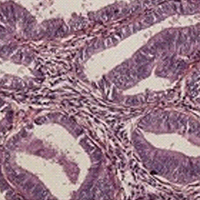PD-L1 expression with QR1 and E1L3N antibodies according to histological ovarian cancer subtype: A series of 232 cases

Submitted: 1 October 2020
Accepted: 10 February 2021
Published: 10 March 2021
Accepted: 10 February 2021
Abstract Views: 949
PDF: 512
HTML: 14
HTML: 14
Publisher's note
All claims expressed in this article are solely those of the authors and do not necessarily represent those of their affiliated organizations, or those of the publisher, the editors and the reviewers. Any product that may be evaluated in this article or claim that may be made by its manufacturer is not guaranteed or endorsed by the publisher.
All claims expressed in this article are solely those of the authors and do not necessarily represent those of their affiliated organizations, or those of the publisher, the editors and the reviewers. Any product that may be evaluated in this article or claim that may be made by its manufacturer is not guaranteed or endorsed by the publisher.
Similar Articles
- C. Pellicciari, On the future contents of a small journal of histochemistry , European Journal of Histochemistry: Vol. 56 No. 4 (2012)
- R. Ambu, L. Vinci, C. Gerosa, D. Fanni, E. Obinu, A. Faa, V. Fanos, WT1 expression in the human fetus during development , European Journal of Histochemistry: Vol. 59 No. 2 (2015)
- Andrea Conz, Clara Alice Musi, Luca Russo, Tiziana Borsello, Luca Colnaghi, Super-resolution study of PIAS SUMO E3-ligases in hippocampal and cortical neurons , European Journal of Histochemistry: Vol. 65 No. s1 (2021): Special Collection on Advances in Neuromorphology in Health and Disease
- Stanislav Ziaran, Stefan Harsanyi, Katarina Bevizova, Zuzana Varchulova Novakova, Branislav Trebaticky, Peter Bujdak, Stefan Galbavy, Lubos Danisovic, Expression of E-cadherin, Ki-67, and p53 in urinary bladder cancer in relation to progression, survival, and recurrence , European Journal of Histochemistry: Vol. 64 No. 2 (2020)
- Brigitta Bonaldo, Antonino Casile, Martina Bettarelli, Stefano Gotti, GianCarlo Panzica, Marilena Marraudino, Effects of chronic exposure to bisphenol A in adult female mice on social behavior, vasopressin system, and estrogen membrane receptor (GPER1) , European Journal of Histochemistry: Vol. 65 No. s1 (2021): Special Collection on Advances in Neuromorphology in Health and Disease
- T. Matsumoto, M. Inayama, I. Tojyo, N. Kiga, S. Fujita, Expression of hyaluronan synthase 3 in deformed human temporomandibular joint discs: in vivo and in vitro studies , European Journal of Histochemistry: Vol. 54 No. 4 (2010)
- A. Bolekova, T. Spakovska, D. Kluchova, S. Toth, J. Vesela, NADPH-diaphorase expression in the rat jejunum after intestinal ischemia/reperfusion , European Journal of Histochemistry: Vol. 55 No. 3 (2011)
- J. Feng, S. Ge, L. Zhang, H. Che, C. Liang, Aortic dissection is associated with reduced polycystin-1 expression, an abnormality that leads to increased ERK phosphorylation in vascular smooth muscle cells , European Journal of Histochemistry: Vol. 60 No. 4 (2016)
- Daša Zupančič, Rok Romih, Immunohistochemistry as a paramount tool in research of normal urothelium, bladder cancer and bladder pain syndrome , European Journal of Histochemistry: Vol. 65 No. 2 (2021)
- ChenHui Zhu, LiJuan Lin, ChangQing Huang, ZhiHui Wu, Activation of Hedgehog pathway by circEEF2/miR-625-5p/TRPM2 axis promotes prostate cancer cell proliferation through mitochondrial stress , European Journal of Histochemistry: Vol. 68 No. 4 (2024)
<< < 36 37 38 39 40 41 42 43 44 45 > >>
You may also start an advanced similarity search for this article.

 https://doi.org/10.4081/ejh.2021.3185
https://doi.org/10.4081/ejh.2021.3185










